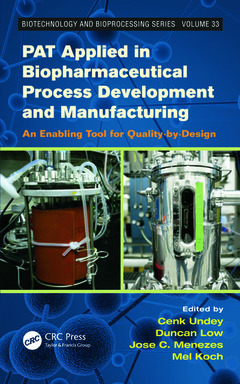PAT Applied in Biopharmaceutical Process Development And Manufacturing An Enabling Tool for Quality-by-Design Biotechnology and Bioprocessing Series
Coordonnateurs : Undey Cenk, Low Duncan, Menezes Jose C., Koch Mel

As with all of pharmaceutical production, the regulatory environment for the production of therapeutics has been changing as a direct result of the US FDA-initiated Quality by Design (QbD) guidelines and corresponding activities of the International Committee for Harmonization (ICH). Given the rapid growth in the biopharmaceutical area and the complexity of the molecules, the optimum use of which are still being developed, there is a great need for flexible and proactive teams in order to satisfy the regulatory requirements during process development.
Process Analytical Technologies (PAT) applied in biopharmaceutical process development and manufacturing have received significant attention in recent years as an enabler to the QbD paradigm. PAT Applied in Biopharmaceutical Process Development and Manufacturing covers technological advances in measurement sciences, data acquisition, monitoring, and control. Technical leaders present real-life case studies in areas including measuring and monitoring raw materials, cell culture, purification, and cleaning and lyophilization processes via advanced PAT. They also explore how data are collected and analyzed using advanced analytical techniques such as multivariate data analysis, monitoring, and control in real-time.
Invaluable for experienced practitioners in PAT in biopharmaceuticals, this book is an excellent reference guide for regulatory officials and a vital training aid for students who need to learn the state of the art in this interdisciplinary and exciting area.
Introduction. Regulatory Perspective of Innovative Process Development Incorporating PAT Tools. ICH QII Guidelines, impact on PAT. Quality-by-Design, Knowledge Management and Continuous Improvement. PAT - Desired State in Biologics Manufacturing. Miniaturization of Measurement Systems and Technology for improved process understanding and rapid screening. Raw Material Characterization via PAT tools. Rapid Microbial Methods and PAT. Glycosylation monitoring for therapeutic protein manufacturing. Real-time Multivariate Process Monitoring, Control and Optimization. First-principles modeling in combination with PAT (improved process understanding). Spectroscopic methods for Biologics manufacturing monitoring and control. On-line HPLC Applications in Cell Culture and in Purification Processes. Process chemometrics, multivariate modeling and analysis. Soft-sensors and their applications in biologics manufacturing. In-line/At-line/On-line Analytics, Sterile Sampling Systems. Drug substance and drug product (incl. lyophilization) PAT tools. Limitations and challenges of current measurement systems in PAT framework. Current state-of-the art in PAT tools for measuring CQAs in near real-time and future research needs. NIH, NFS and NIST Research Directions towards enabling PAT tools for biologics manufacturing end-point monitoring, control and real-time release opportunities. New sensor technologies and its impact on PAT. PAT Business Case Development, Implementation Challenges and Benefits. PAT as a Manufacturing Excellence Contributor, Its Relations to Lean Manufacturing. Future Directions in PAT.
Date de parution : 01-2012
Ouvrage de 326 p.
15.6x23.4 cm
Thèmes de PAT Applied in Biopharmaceutical Process Development And... :
Mots-clés :
Nuclear Magnetic Resonance; Manometric Temperature Measurements; Process analytical technology; QbD Framework; process development; PAT Tool; biopharmaceutical; PAT Apply; Biochemistry; Moisture Content; Cycle Time; Raw Material; PLS Model; NIR Spectroscopy; Cell Culture Processes; Ich Q8; PLS; Biopharmaceutical Process Development; Cell Culture; Contribution Plot; Biopharmaceutical Manufacturing; PCA Model; Secondary Drying; Data Sets; Batch Unit Operations; Primary Drying; HCCF; Antibody Reduction; Unit Operation



